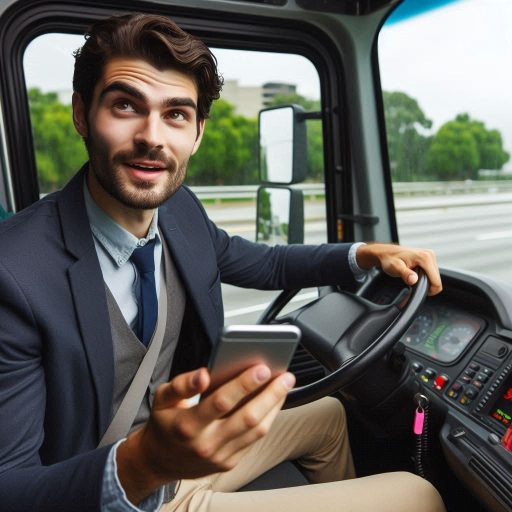Introduction
Technology has transformed bus driving, making it safer, more efficient, and environmentally friendly.
The integration of modern innovations is reshaping the public transportation industry.
Bus drivers now rely on advanced systems to navigate routes, communicate with passengers, and improve overall performance.
These advancements are vital as cities grow, and the demand for efficient public transport increases.
The importance of technology in bus driving cannot be overstated.
Innovations have helped reduce human error, making roads safer for everyone.
Automated systems allow drivers to focus more on passengers, while technology handles complex tasks.
For example, buses equipped with collision detection and lane-keeping assist systems are now standard in many cities.
These systems alert drivers to potential hazards and correct the vehicle‘s course if needed.
Moreover, modern innovations enhance the environmental sustainability of buses.
Electric buses are becoming increasingly common, reducing emissions and dependence on fossil fuels.
Many cities are transitioning their fleets to electric or hybrid models, contributing to cleaner air and a greener future.
In addition, buses are now designed with energy-efficient materials and systems, further decreasing their environmental impact.
Another key innovation is the use of GPS and real-time tracking technology.
This allows bus operators to optimize routes, improve punctuality, and reduce fuel consumption.
Passengers benefit as well, with apps providing live updates on bus locations and arrival times.
This seamless integration of technology into public transportation makes commuting more convenient and reliable for everyone.
The Evolution of Technology in Bus Transportation
Technology in bus transportation has evolved significantly, transforming the industry into a more efficient and safe system.
From basic mechanical improvements to today‘s advanced automation, innovation has continuously shaped how buses operate.
The History of Technology in Bus Driving
In the early days, buses were simple machines, relying on basic engines and manual controls.
The first motorized buses emerged in the late 1800s, marking the shift from horse-drawn carriages to motor vehicles.
As cities grew, demand for better public transport rose, spurring advancements in bus technology.
Key Milestones and Advancements
One major milestone was the introduction of automatic transmission in the 1940s.
This innovation made driving easier and more accessible, reducing driver fatigue.
Over time, buses became larger and more reliable, handling increased passenger loads with ease.
In the 1950s, power steering revolutionized bus driving by improving control and maneuverability.
Drivers could now navigate heavy vehicles with minimal effort, enhancing safety and comfort.
The 1970s saw the rise of diesel engines, boosting efficiency while lowering operating costs for transit agencies.
The 1990s brought computerized systems, marking a major leap in bus technology.
These systems improved fuel management, diagnostics, and maintenance, optimizing overall performance.
GPS tracking emerged in the early 2000s, allowing real-time monitoring of bus routes and schedules.
This innovation led to improved reliability and punctuality for passengers.
More recently, electric buses have gained popularity due to their environmental benefits.
Cities worldwide are adopting electric fleets, reducing carbon emissions and noise pollution.
The shift toward sustainable transport has been a critical milestone in modern bus technology.
How Technology Has Changed the Industry
Automation is now the next frontier in bus transportation.
Advanced driver-assistance systems (ADAS) include collision detection, automatic braking, and lane-keeping technologies.
These systems significantly enhance safety, reducing the risk of accidents on the road.
Bus design has also evolved, with modern buses incorporating Wi-Fi, USB ports, and digital displays.
These features improve passenger experience, making public transport more convenient and user-friendly.
Innovations in wheelchair accessibility and low-floor designs have further enhanced inclusivity, allowing easier boarding for people with mobility challenges.
Today, buses are smarter and more efficient than ever before.
Smart ticketing systems allow passengers to pay fares using mobile apps or contactless cards, streamlining the boarding process.
This speeds up service and reduces operational costs for transport operators.
Technology has transformed the bus industry by improving safety, efficiency, and sustainability.
With advancements in automation and eco-friendly solutions, the future of bus transportation looks even more promising.
Public transit will continue to benefit from innovations that make it more reliable, accessible, and environmentally friendly.
Read: Nail Technician Networking: Building Industry Connections
Benefits of Modern Technology in Bus Driving
Modern technology has transformed bus driving, making it safer, more efficient, and convenient for both drivers and passengers.
Improved Safety Features Such as Automatic Braking Systems
One of the most significant advancements is improved safety features like automatic braking systems.
These systems detect obstacles and apply brakes automatically, reducing accidents caused by human error.
Automatic braking ensures that buses stop in time to avoid collisions, even in challenging traffic conditions.
Enhanced Communication Tools for Drivers and Passengers
Enhanced communication tools have also revolutionized how bus drivers and passengers stay connected.
Modern buses are equipped with real-time communication systems that allow drivers to receive updates from dispatchers instantly.
These tools help drivers respond quickly to route changes, delays, or emergencies, ensuring smoother operations.
Passengers also benefit from these technologies by receiving real-time updates on bus arrivals, delays, or route changes via mobile apps and onboard displays.
Efficiency in Routes and Scheduling Through GPS Technology
GPS technology has dramatically improved the efficiency of bus routes and scheduling.
With precise tracking, buses can follow optimized routes, avoiding traffic congestion and reducing travel time.
GPS systems also allow bus companies to monitor vehicles in real-time, ensuring that buses run on time and stick to their schedules.
This not only improves passenger satisfaction but also reduces fuel consumption and operational costs.
Automatic braking, enhanced communication, and GPS technology have collectively enhanced the overall experience of bus travel.
Drivers are less stressed and more focused, knowing that they have support from advanced safety and navigation systems.
For passengers, these technologies provide peace of mind, knowing that buses are safer, more reliable, and better connected to real-time information.
Additionally, modern buses often feature onboard diagnostics systems that monitor vehicle performance.
These systems alert drivers to potential issues before they become serious problems, reducing the risk of breakdowns.
By addressing maintenance needs proactively, buses can stay in better condition for longer, resulting in fewer delays and improved reliability.
The benefits of modern technology in bus driving extend beyond safety and efficiency.
These innovations also contribute to environmental sustainability.
GPS-guided routes reduce unnecessary idling and fuel consumption, lowering the carbon footprint of bus operations.
Many modern buses are also integrating electric or hybrid technologies, further reducing emissions and supporting eco-friendly public transportation.
In review, the integration of modern technology in bus driving has brought numerous benefits.
Automatic braking systems enhance safety, communication tools keep drivers and passengers informed, and GPS technology ensures efficient routing and scheduling.
These advancements make bus travel safer, faster, and more environmentally friendly, benefiting everyone involved.
As technology continues to evolve, the future of bus driving promises even greater improvements in safety, efficiency, and passenger experience.
Read: The Role of Technology in Modern Pet Grooming
Impact of Electric Buses on the Environment
The Rise of Electric Buses in the Transportation Sector
Electric buses are transforming the transportation sector by offering an eco-friendly alternative to traditional diesel buses.
As cities grow, the need for sustainable public transportation solutions has increased.
Electric buses have risen to meet this challenge, reducing reliance on fossil fuels.
Many cities and transportation companies are now prioritizing electric bus adoption to lower their carbon footprint.
The Environmental Benefits of Switching to Electric Vehicles
One of the main drivers behind the rise of electric buses is their significant environmental benefits.
Traditional buses emit harmful pollutants like carbon dioxide (CO2), nitrogen oxides, and particulate matter.
These emissions contribute to air pollution, climate change, and various health problems.
Electric buses, on the other hand, produce zero tailpipe emissions.
By switching to electric vehicles, cities can reduce greenhouse gas emissions and improve air quality.
The environmental benefits of electric buses extend beyond just emissions.
Electric buses are more energy-efficient than their diesel counterparts.
They use energy from renewable sources like wind, solar, and hydropower.
This helps reduce the overall carbon footprint of public transportation systems.
Additionally, electric buses are quieter, which reduces noise pollution in urban areas.
Initiatives by Companies to Reduce Carbon Emissions
Several companies and governments are taking bold steps to transition to electric bus fleets.
For example, China is leading the charge with the largest number of electric buses in the world.
Cities like Shenzhen have already fully electrified their public bus systems.
In the United States, companies like Proterra and BYD are working with cities to introduce electric buses.
These efforts are part of a broader push to meet global carbon reduction targets.
In Europe, initiatives such as the Clean Bus Deployment Initiative encourage cities to invest in electric buses.
This program supports the EU’s goal of achieving carbon neutrality by 2050.
Other regions, like Latin America and Africa, are also exploring electric bus solutions to tackle urban pollution and promote sustainability.
Private companies are also playing a significant role in reducing carbon emissions through electric bus innovations.
Manufacturers are improving battery technology to extend the range and efficiency of electric buses.
This has made electric buses more attractive to cities that require longer travel distances.
Additionally, companies are focusing on improving the charging infrastructure, making it easier for fleets to transition to electric power.
In essence, electric buses offer a cleaner, more sustainable solution for public transportation.
Their adoption is crucial in the fight against climate change.
By reducing carbon emissions and improving urban air quality, electric buses are helping cities achieve their sustainability goals.
The rise of electric buses is an important step toward creating a greener future for transportation.
Read: Customer Service Tips for Pet Grooming Professionals

The Role of Automation in Bus Driving
Automation technologies have significantly impacted the way buses operate in recent years.
These advancements have revolutionized the transportation industry by making buses safer, more efficient, and more environmentally friendly.
How Automation Technologies Are Changing the Way Buses Operate
Automation technologies, such as advanced driver-assistance systems (ADAS) and autonomous driving systems, have played a crucial role in transforming the bus driving experience.
These technologies have enabled buses to navigate busy city streets with precision and accuracy, reducing the risk of accidents and improving overall traffic flow.
One key aspect of automation in bus driving is the use of sensors and cameras that help buses detect and avoid obstacles on the road.
These sensors can detect pedestrians, cyclists, and other vehicles, allowing buses to make informed decisions in real-time to prevent collisions.
Another important aspect of automation technologies in buses is the integration of GPS systems and mapping software.
These technologies enable buses to optimize their routes, minimize travel time, and reduce fuel consumption.
By leveraging GPS data, buses can avoid congestion and navigate more efficiently, ultimately saving time and reducing emissions.
Advancements in Autonomous Driving Systems
Autonomous driving systems have been a game-changer for the bus transportation industry.
These systems use artificial intelligence and machine learning algorithms to enable buses to operate without human intervention.
By leveraging sensors, cameras, and radar systems, autonomous buses can navigate complex traffic scenarios, pick up passengers, and drop them off at their destinations safely.
One of the key benefits of autonomous driving systems is their ability to enhance road safety.
These systems can react faster than human drivers, reducing the risk of accidents caused by human error.
Additionally, autonomous buses can communicate with each other, coordinating their movements to optimize traffic flow and prevent congestion.
Advancements in autonomous driving systems have also led to increased efficiency in bus transportation.
These systems can operate buses with greater precision, leading to reduced fuel consumption and lower emissions.
By optimizing routes and reducing idle time, autonomous buses can improve overall transport efficiency and reduce costs for operators.
Concerns and Challenges Related to Automation in Bus Transportation
While automation technologies have the potential to revolutionize bus transportation, there are also concerns and challenges that need to be addressed.
One of the main concerns is the issue of cybersecurity.
As buses become more connected and reliant on technology, they become vulnerable to cyber attacks that could compromise passenger safety and privacy.
Another challenge associated with automation in bus transportation is the potential displacement of jobs.
As autonomous driving systems become more prevalent, there is a risk of bus drivers losing their jobs.
It is essential for policymakers and industry stakeholders to consider the impact of automation on employment opportunities and develop strategies to mitigate any negative consequences.
Furthermore, there are legal and regulatory challenges that need to be addressed to ensure the safe and effective implementation of automation technologies in bus transportation.
Clear guidelines and standards must be established to govern the operation of autonomous buses and ensure that they comply with existing laws and regulations.
In short, automation technologies have the potential to transform the bus transportation industry, making buses safer, more efficient, and more environmentally friendly.
By leveraging advancements in autonomous driving systems, buses can navigate city streets with precision and accuracy, reducing the risk of accidents and optimizing traffic flow.
However, it is essential to address concerns and challenges related to automation, such as cybersecurity, job displacement, and regulatory issues, to ensure a smooth transition to a more automated future in bus driving.
Read: Nail Technician Etiquette: Dos and Don‘ts
Transform Your Career Today
Unlock a personalized career strategy that drives real results. Get tailored advice and a roadmap designed just for you.
Start NowDiscover More: Networking Tips for Aspiring Chauffeurs
Integration of Mobile Apps for Bus Passengers
Modern bus transportation has significantly evolved with the integration of mobile apps.
Passengers now have instant access to crucial information, enhancing their travel experience.
Mobile apps provide real-time updates on bus schedules and routes, allowing users to plan their journeys efficiently.
Instead of waiting at bus stops, passengers can track buses from their phones, ensuring they don‘t miss a ride.
The Use of Mobile Apps for Route Information and Ticketing
One of the most beneficial features of these apps is route information.
Gone are the days of printed schedules and confusion about bus stops.
Now, passengers can enter their destination, and the app instantly provides the best route, estimated arrival times, and transfer options.
This helps commuters avoid unnecessary delays and adjust plans according to live updates.
Furthermore, these apps often provide notifications about delays, road closures, or changes in service, keeping users informed at all times.
Ticketing has also become more streamlined through mobile apps.
Instead of carrying cash or physical tickets, passengers can purchase digital tickets directly through the app.
This reduces the need for long lines at ticket counters and minimizes cash transactions on the bus.
Digital ticketing is quick, secure, and allows passengers to store multiple tickets or passes for future use.
Many apps offer discounted fares or loyalty rewards for regular passengers, making travel more affordable.
The Convenience of Mobile Apps for Passengers
The convenience of mobile apps for bus passengers is undeniable.
With just a few taps, riders can manage every aspect of their trip, from planning routes to buying tickets.
These apps save time, reduce stress, and provide a sense of control over commuting.
Passengers no longer need to worry about missing a bus or carrying exact change, making the entire process more seamless.
How Technology Is Improving the Overall Experience for Riders
Mobile technology is improving the overall experience for bus riders by simplifying interactions and enhancing communication.
It fosters better engagement between transit providers and passengers, allowing feedback and reporting of service issues directly through the app.
Riders can also access additional services such as finding nearby bus stops, checking the weather, or setting reminders for their next ride.
This increased efficiency in public transit systems leads to higher passenger satisfaction and encourages more people to use buses as a sustainable mode of transportation.
In general, the integration of mobile apps in bus transportation has revolutionized the way passengers travel.
From providing accurate route information to enabling digital ticketing, these innovations have made commuting easier, faster, and more convenient.
As technology continues to evolve, the future of bus travel will only become more user-friendly and efficient.
Future trends in bus driving technology
As technology continues to evolve at a rapid pace, the field of bus driving is also experiencing significant advancements.
Let’s explore some future trends in bus driving technology and the potential impact of these innovations on the transportation industry.
Predict upcoming innovations in the field
One of the most anticipated innovations in bus driving technology is the development of autonomous buses.
These self-driving vehicles have the potential to revolutionize the way we think about public transportation.
With the integration of artificial intelligence and machine learning, these buses can navigate through traffic, pick up passengers, and drop them off at their destinations without the need for a human driver.
Another exciting innovation is the use of electric and hybrid buses.
As concerns about climate change and air pollution continue to grow, there is a push towards more sustainable forms of transportation.
Electric and hybrid buses are eco-friendly alternatives to traditional diesel-powered vehicles, offering reduced emissions and lower operating costs.
The potential impact of artificial intelligence and machine learning
Artificial intelligence and machine learning are poised to have a transformative impact on the field of bus driving.
These technologies can improve safety, efficiency, and overall passenger experience.
AI-powered systems can analyze traffic patterns, optimize routes, and even predict maintenance needs before they occur.
Machine learning algorithms can continuously learn and adapt to changing conditions, making buses safer and more reliable.
With the implementation of AI and machine learning, buses can become more autonomous and efficient.
This means fewer accidents, reduced traffic congestion, and better service for passengers.
Additionally, these technologies can help bus drivers make better decisions on the road, ultimately leading to a more streamlined and effective transportation system.
How technology will continue to shape the future of bus transportation
The future of bus transportation is undoubtedly intertwined with technology.
Advancements in areas such as connectivity, automation, and electrification will continue to shape the industry in the years to come.
As more cities embrace smart transportation solutions, buses will play a vital role in providing sustainable and efficient mobility options for residents.
All in all, the future of bus driving technology holds incredible promise for improving the way we commute and travel.
With the integration of artificial intelligence, machine learning, and other cutting-edge technologies, buses are set to become smarter, safer, and more sustainable than ever before.
As we look ahead to the next wave of innovations, it’s clear that technology will continue to play a pivotal role in shaping the future of bus transportation.
Conclusion
In this blog post, we explored the significant impact of modern technology on bus driving.
We discussed various innovations transforming the industry, enhancing safety, efficiency, and passenger experience.
Technologies such as GPS tracking and real-time data analysis have revolutionized route management.
These advancements help drivers navigate more effectively and respond to changing conditions.
Moreover, we examined how automated driving systems improve operational efficiency.
These systems allow buses to run on schedule and reduce human error.
As a result, passengers enjoy a more reliable service.
Safety features like collision avoidance systems also protect both passengers and pedestrians.
They create a safer environment for everyone involved.
We also highlighted the role of mobile apps in enhancing passenger convenience.
These apps provide real-time updates on bus schedules and delays.
Passengers can track their bus and plan their journeys more effectively.
This integration of technology fosters a seamless travel experience, encouraging public transportation use.
Furthermore, we discussed how electric and hybrid buses contribute to sustainability.
These vehicles reduce emissions and promote greener transportation options.
By adopting these technologies, transit authorities demonstrate their commitment to the environment.
They attract eco-conscious passengers and improve air quality in urban areas.
Finally, we addressed the importance of ongoing training for drivers in using new technologies.
[E-Books for Sale]
The Big Book of 500 High-Paying Jobs in America: Unlock Your Earning Potential
$19.99 • 500 High-Paying Jobs • 330 pages
Explore 500 high-paying jobs in America and learn how to boost your career, earn more, and achieve success!
See All 500 High-Paying Jobs of this E-Book
1001 Professions Without a Degree: High-Paying American Jobs You Can Start Now
$19.99 • 1001 Professions Without a Degree • 174 pages
Discover 1001 high-paying jobs without a degree! Unlock career tips, skills, and success strategies for just $19.99!




